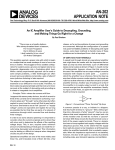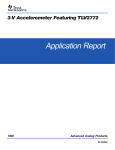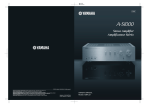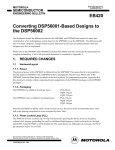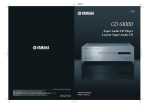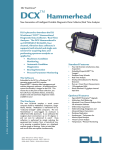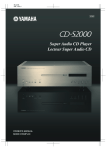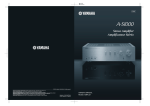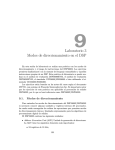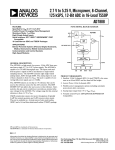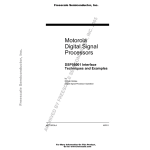Download AN-400 APPLICATION NOTE
Transcript
a ONE TECHNOLOGY WAY AN-400 APPLICATION NOTE • P.O. BOX 9106 • NORWOOD, MASSACHUSETTS 02062-9106 • 617/329-4700 Considerations for Selecting a DSP Processor—Why Buy the ADSP-2181? (The Analog Devices ADSP-2181 vs. Texas Instruments & Motorola Fixed-Point DSPs) INTRODUCTION You should use the ADSP-2181 Digital Signal Processor for your high performance, fixed-point DSP applications because this processor provides all the memory, I/O, and interface support you need in a single chip. Table I shows a comparison of the ADSP-2181, TMS320C5x, and DSP56000 processors. The ADSP-2181 beats the other DSPs with the following features: • 32K words of on-chip RAM (nearest competitor has 9.5K words) • Glue-less (no decode required) interface for off-chip RAM and I/O peripherals • Integrated 8 and 16-bit DMA support COMPARING THE DSP PROCESSORS—ADSP-2181, TMS320C5X, AND DSP56000 The point of comparing DSP processors is to determine which provides the features you need to develop your DSP system and run your DSP applications. This section first examines typical system and algorithm requirements then reviews how each of the DSPs meet these needs. DSP applications require high speed RAM. Data and instructions for the DSP are stored in RAM and accessed at run time. As shown in Table II, many common RAMintensive applications require 9.5K words of RAM or more; this information was gathered from Analog Devices applications engineers using ADSP-2100 Family DSPs. This application note explains how the ADSP-2181’s onchip RAM, off-chip RAM & I/O interface, and integrated DMA support provide increased performance and decreased system costs compared to Texas Instruments and Motorola fixed-point DSPs. To support these types of applications, DSP systems must either use a DSP with sufficient on-chip RAM or include sufficient off-chip DSP RAM. And, the RAM used must have a fast enough access speed to not impair the DSP’s operation. From the data in Tables I and II, you can see that the ADSP-2181 is the only fixed-point DSP that provides sufficient on-chip RAM to support all these typical DSP algorithms. Table I. Comparison of Fixed-Point DSP Costs and Features DSP Processor ADSP-2181 DSP56002 TMS320C50 TMS320C53 On-Chip RAM 32K words 1K word 9.5K words 3.5K words “Glue-Less” Off-Chip RAM and I/O Interface? Yes No No No DSP Instruction Rate 33 MIPS 20 MIPS 40 MIPS 40 MIPS Table II. Typical DSP Algorithms with Approximate MIPS and Memory Requirements Algorithm Approximate MIPS Required Approximate RAM Required V.32bis or V.32terbo FAX/Modem 16 16K words PM, 16K words DM 20 Voice Music Synthesis 20 6K words PM, 4K words DM Full Duplex Speaker Phone 13 2K words PM, 2K words DM Digital Answering Machine 8 5K words PM, 1K word DM GSM, 13 kbps Compression/Decompression 4 2K words PM, 1K word DM CELP, 4.3 or 7.5 kbps Compression/Decompression 12.5 1.5K words PM, 1.5K words DM MPEG Layer2, 64 kbps Compression 16 5K words PM, 4K words DM MPEG Layer2, 64 kbps Decompression 10 1K words PM, 8.5K words DM Dolby AC-2, 117 kbps Compression/Decompression 13 4K words PM, 8.5K words DM All DSP systems have some type of peripherals (DACs, ADCs, CODECs, etc.) connected to the DSP. Many DSPs include specialized interface ports (serial, parallel, or both) for these peripherals. For connecting parallel I/O DSP peripherals, a DSP with a separate I/O memory space, I/O control lines, and I/O specific instructions provides some advantages. Having a separate I/O space for peripherals implies that you do not have to use DSP memory addresses to memory map the external I/O devices. By supporting control lines to external I/O peripherals, the DSP reduces the amount of decode and control logic needed in your system. I/O specific instructions for controlling the I/O interface ease I/O programming. There are two factors that influence the access time (speed) of RAM needed in DSP systems—DSP instruction rate and decode logic. At DSP instruction rates of 25 MIPS and higher, SRAM with access times of 15 ns or less are required for full-speed DSP operation (zero wait state). Systems using address decoding logic require SRAM with faster access times to compensate for the delay incurred by the decoding. Another important issue tied to using off-chip RAM in a DSP system is the time involved in designing, debugging, and using an interface for off-chip RAM. From the number of application notes, articles, and user’s manual pages devoted to developing interfaces for off-chip RAM by all DSP vendors, it is easy to conclude that building an off-chip RAM interface requires a considerable design time investment. The sections that follow describe the features of each processor, and the conclusion section of this note presents a table of the comparison results. Each comparison feature contributes or detracts from the ease of DSP system and software development. The comparison topics covered are the following: DSP systems that use off-chip RAM face a performance bottleneck. Many DSP operations require two reads from data memory and one read from program memory. The ADSP-2181, with its large on-chip RAM and triple internal memory bus, can complete these accesses and execute the instruction in one instruction cycle. Using an off-chip memory interface on other DSPs to complete this same operation requires three instruction cycles for the memory reads alone. • Internal DSP RAM Size • External Memory and I/O Interface • System Design Simplicity The Texas Instruments TMS320C5x The TMS320C5x DSPs are general purpose 16-bit, fixed-point DSPs. Depending on the device version, TMS320C5x parts include up to 9.5K words of on-chip program/data RAM, up to 16K words of ROM, a standard serial port, a time-division-multiplexed (TDM) serial port, and a 16-bit timer. The four variations of the TMS320C5x are TMS320C50 (9.5K words on-chip RAM), TMS320C51 (1.5K words on-chip RAM), TMS320C52 (1K word on-chip RAM), and TMS320C53 (3.5K words on-chip RAM). Table III lists the comparison features for the TMS320C52 processor. One technique for reducing DSP overhead (the number of DSP cycles/access) related to RAM access is Direct Memory Accessing (DMA). Using DMA, an external device can access internal DSP memory without any intervention by the DSP. This easy access to DSP internal RAM lets you interface the DSP and host devices without incurring a lot of DSP overhead with each DMA data transfer. –2– Table III. TMS320C52 Comparison Features Comparison Features TMS320C52 Supports . . . On-Chip Memory 1K × 16-bit on-chip total RAM. This memory is available as data and program memory. (Some instructions require multiple locations for storage, reducing the amount of on-chip RAM availability.) Off-Chip Memory Access Access to off-chip memory requires a minimum of two cycles on all external memory writes. Nominal memory access time is 12 ns using a TMS320C52 at 80 MHz. (To access RAM or peripherals requires asserting the RAM’s OE signal continuously and using the DSP’s R/W and STRB signals for memory selection. This technique continuously drives the bus leading to contention and power usage issues.) I/O Peripheral Interface 64K × 16-bit I/O Space for peripheral interfacing. Has dedicated control lines and DSP instructions for accessing I/O space directly. Direct Memory Accessing An external DMA controller interface, but DSP operation is suspended during DMA transfers. Block DMA transfers require DSP intervention. If you need to support any of the typical DSP algorithms mentioned with a TMS320C53 based system, your system might look something like the system shown in Figure 1 (peripherals may vary). The DSP requires additional external memory with decode logic to access the memory and peripherals. These additional components add time and expense to the development/debugging process. While the TMS320C53 does support a separate I/O space and DMA, accessing external memory does saddle the DSP with additional overhead (wait states). FOUR 16K x 4-BIT EXTERNAL SRAMs TMS320C53 WE R/W RD OE DATA DATA ADDRESS ADDRESS RAM ENABLE STRB0 DS A13 ADDRESS DECODE LOGIC A14 DAC ENABLE WE RD ADDRESS The Motorola DSP56000 The DSP56000/100 DSPs are general purpose 24- and 16-bit, fixed-point DSPs. Depending on the device version, DSP56000/100 parts include up to 1K word of onchip program/data RAM, a parallel host interface, two serial ports, a codec, a timer, and some ROM coded variations. The variations of the DSP56000/100 DSPs include DSP56001 (24-bit with on-chip ROM companding & sine tables), DSP56002 (24-bit), DSP56156 (16-bit), and DSP56166 (16-bit with on-chip boot ROM). Table IV lists the comparison features for the DSP56002 processor. CS DATA (40 MIPS DSP WITH 3.5K WORDS INTERNAL RAM) CS WR RD ADDRESS DATA DAC Figure 1. TMS320C53 with Added Memory, Decode Logic, and DAC Table IV. DSP56002 Comparison Features Comparison Features DSP56002 Supports . . . On-Chip Memory 256 Words X memory, 256 Words Y memory, and 512 Words program memory. Off-Chip Memory Access Access to off-chip memory in one DSP instruction cycle is possible. Nominal memory access time is 15 ns for zero wait state using a 56002 at 66 MHz. I/O Peripheral Interface No distinct I/O Space. External peripherals must be memory mapped, requiring address decoding in external memory space. A DSP system with this configuration requires address decode logic, implying the need for faster S RAM to maintain zero wait state performance. Direct Memory Accessing No support for DMA to external memory or peripherals. –3– Four ports, with integrated DMA control on the ADSP2181, let external devices transfer data and instructions to the DSP’s RAM without interrupting the processor. A 16-bit parallel Internal DMA (IDMA) port lets an external processor upload or download data and instructions to the ADSP-2181s on-chip RAM. The IDMA port can also perform a power-up boot of the ADSP-2181. An 8-bit parallel Byte Memory DMA (BDMA) port lets the DSP access data stored in 8-bit wide memories through the external data bus. As with the IDMA port, the ADSP-2181 can use the BDMA port for run time memory access or booting. Two serial ports with built-in DMA circuitry let the DSP transfer data directly to and from the on-chip RAM from CODECs or other I/O devices. All DMA transfers occur in the background while the DSP is executing code. Table V lists the comparison features for the ADSP-2181 processor. If you need to support any of the typical DSP algorithms mentioned with a DSP56002 based system, your system might look something like the system shown in Figure 2 (peripherals may vary). The DSP requires additional external memory with decode logic to access the memory and peripherals. These additional components add time and expense to the development/debugging process. Because the DSP56002 does not support a separate I/O space or DMA, accessing external memory or peripherals saddles the DSP with additional overhead (wait states). THREE 32K x 8-BIT EXTERNAL SRAMS DSP56002 WR R/W RD OE DATA DATA ADDRESS ADDRESS RAM ENABLE CE Because the ADSP-2181 has all the internal RAM you need to support any of the typical DSP algorithms mentioned, an ADSP-2181 system is simpler to design as shown in Figure 3. The DSP does not require any additional external memory with decode logic to access the memory and peripherals. The ADSP-2181’s support for a separate I/O space and DMA eases host interface design and peripheral I/O programming. CS PS DS X/Y A13 ADDRESS DECODE LOGIC A14 DAC ENABLE CS WR WR RD ADDRESS RD ADDRESS DATA DATA (20 MIPS DSP WITH 1.5K WORDS INTERNAL RAM) DAC ADSP-2181 Figure 2. DSP56002 with Added Memory, Decode Logic, and DAC CMS The Analog Devices ADSP-2181 The ADSP-2181 is a general purpose, 16-bit, fixed-point DSP. It is based on, and is code compatible with, the Analog Devices ADSP-2100 Family. The on-chip memory includes 16K × 24-bit Program Memory (PM) and 16K × 16-bit Data Memory (DM), providing 32K words of on-chip RAM. The DSP can access PM and DM RAM twice every DSP cycle through an internal three bus architecture. This architecture lets the DSP fetch the next instruction and two operands from on-chip memory in a single cycle. AD7769 CS WE WR RD RD ADDRESS DATA ADDRESS DATA (DAC) (33 MIPS DSP WITH 32K WORDS INTERNAL RAM) Figure 3. ADSP-2181 with Added DAC Table V. ADSP-2181 Comparison Features Comparison Features ADSP-2181 Supports On-Chip Memory 32K words on-chip total RAM. Off-Chip Memory Access Access to off-chip memory is possible in one DSP instruction cycle. Nominal memory access time is 12 ns using an ADSP-2181 at 33 MHz. I/O Peripheral Interface 2K × 16-bit I/O Space for peripheral interfacing. Has dedicated control lines and DSP instructions for accessing I/O space directly. Direct Memory Accessing An internal DMA controller interface. The “cycle stealing” DMA technique lets the DSP continue operation unimpeded by DMA transfers. –4– CONCLUSION The ADSP-2181 is the clear leader among the DSPs compared in this note. With its large internal RAM, integrated DMA control and I/O interfaces, the ADSP-2181 provides more system support than any other 16-bit, fixed-point DSP. Table VI provides a summary of the comparison information. Table VI. DSP Comparison Summary Comparison Features ADSP-2181 DSP56002 TMS320C53 On-Chip Memory 32K words 1.5K words 3.5K words Off-Chip Memory Access 2 Accesses per DSP instruction cycle, no decode hardware needed 1 Access per DSP instruction cycle possible, external decode hardware needed (for memory and I/O) 1 Access takes two DSP instruction cycles, external decode hardware needed (for memory and I/O) I/O Peripheral Interface Integrated I/O space support, no decode hardware needed No I/O space support Integrated I/O space support, external decode hardware needed (for memory and I/O) Direct Memory Accessing Integrated DMA support, “cycle stealing” DMA No DMA support Support for an external DMA controller, but DSP operation is suspended during DMA transfers REFERENCES The following sources contributed information to this applications note: ADSP-2100 Family User’s Manual, Analog Devices, Inc., (82-000780-02, Prentice-Hall, 1994) Buyer’s Guide to DSP Processors, Berkeley Design Technology, Inc., February, 1994. ADSP-2171/81 User’s Manual, Analog Devices, Inc., (82000763-01, 1994) DSP56000/DSP56001 Digital Signal Processor User’s Manual, Motorola, (DSP56000UM/AD, Rev 1) Child, J., Higher Levels Of Integration Come To DSPs, (Computer Design, May 1994) TMS320C5x User’s Guide, Texas Instruments, (25473019721 revision D, January 1993) Leonard, J., EDN’s 1994 DSP-Chip Directory, (Electronic Design News, June 9, 1994) TMS320 DSP Designer’s Notebook Number 41—Supporting External DMA Activity to Internal RAM for TMS320C5x Devices With the PZ Package, Texas Instruments, (5/94) –5– –6– PRINTED IN U.S.A. E2020–4–5/95






